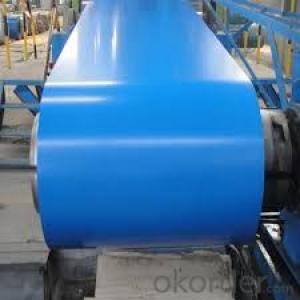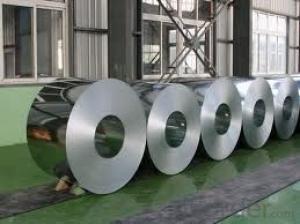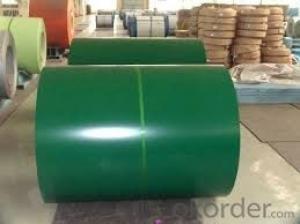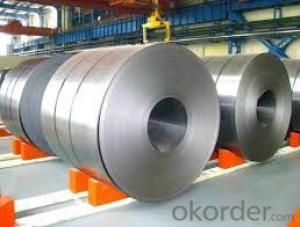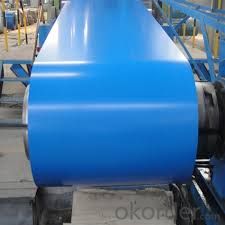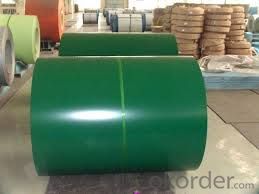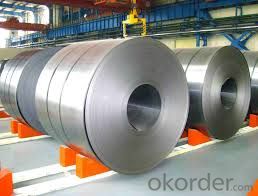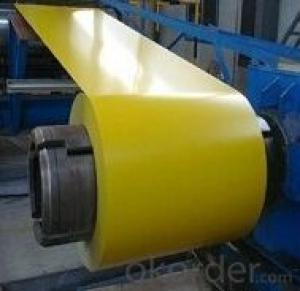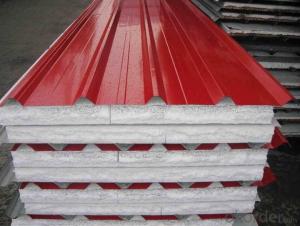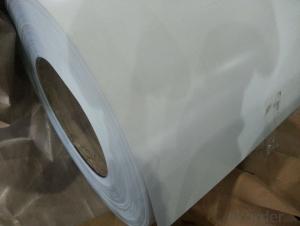Prepainted Steel Coil Colour Coated Steel Coil Supplier
- Loading Port:
- Shanghai
- Payment Terms:
- TT OR LC
- Min Order Qty:
- 50 m.t.
- Supply Capability:
- 10000 m.t./month
OKorder Service Pledge
OKorder Financial Service
You Might Also Like
Quick Details
| Standard: | AISI,ASTM,BS,DIN,GB,JIS | Grade: | SGCC DX51D | Thickness: | 0.146-1.2mm |
| Place of Origin: | Shandong China (Mainland) | Brand Name: | CNBM | Model Number: | 0.146MM-1.2MM*1250MM OR UNDER |
| Type: | Steel coil ,Steel sheets/plates,Corrugated steel sheets/plates | Technique: | Hot rolled-cold rolled- galvanized Surface Treatment Galvanized | Surface Treatment: | Galvanized |
| Application: | Structural use ,roofing, commercial use, household appliance, industry | Special Use: | High-strength Steel Plate | Width: | 800-1250mm |
| Length: | C |
Packaging & Delivery
| Packaging Detail: | standard packing to export 4 eye bands and 3 circumferential bands in steel, galvanized metal fluted rings on inner and outer edges, galvanized metal & waterproof paper wall protection disk, galvanized metal & waterproof paper around circumfer |
| Delivery Detail: | 7--30days after receiving deposit |
Specifications
Color Coated Steel Coil:SGCC DX51D
Capability:Waterproof Rustless
Place of Origin:Shandong, China (Mainland)
Our Product Introduction
Hot-Dipped Galvanized Steel Coil:SGCC DX
Thickness: 0.146-1.2mm
Width:800-1250mm
Spangle: Regular Big Mini Non-spangle
CNBM INTERNATIONAL
CNBM International Corporation (CNBM International) is the most important trading platform of
CNBM Group Corporation, a state-owned company under the direct supervision of State-owned Assets
Supervision and Administration Commission of the State Council.
As of the end of 2012, CNBM’s total assets exceeded RMB 300 billion, with more than 150,000
employees, and 20 companies under direct management with 100% share control or majority control,
among which 6 were listed companies, including 2 overseas listed. CNBM ranked NO.319 in the Top
Fortune World 500 of 2013 with 34.46 billion dollars revenue.
For now, we have established strategic partnerships with hundreds of domestic manufacturers and
extensive business relations with clients from over 120 countries in the fields of building materials and
equipments by making full use of its absolute superiority in both abundant source and solid technology
support. Currently, we have wholly-owned overseas subsidiaries and branches in 5 countries with a view
to realize localization, which also represents an essential progress in our globalization target.
STEEL SHEET/COIL DEPARTMENT
Our department is specialized in manufacturing and exporting the following products.
HOT ROLLED STEEL
COLD ROLLED STEEL
HOT-DIP GALVANIZED/ALUZINC STEEL
PRE-PAINTED GALVANIZED/ALUZINC STEEL
PRINTING STEEL
We can ensure that stable quality standards are maintained, strictly meeting both market
requirements and customers’ expectations. Our products enjoy an excellent reputation and have been
exported to Europe, South-America, the Middle-East, Southeast-Asia, Africa and Russia etc.. We sincerely
hope to establish good and long-term business relationship with your esteemed company.
COMPANY
PROFILE
- 1 -
- 2 -
Steel Coil/Sheet
CNBM UAE
CNBM INDIA
CNBM GERMANY
CNBM BRAZIL
CNBM K.S.A
CNBM INDONESIA
CNBM THAILAND
CNBM SOUTH AFRICA
- Q: Eutectoid Steel
- Eutectic steel is used to produce pearlite, bainite, spheroidite and martensite steels. Those steels vary in strength, hardness and ductility. One uses martensite steel for example in razor blade manufacturing. Of course there is no end to the various uses of these steels.
- Q: What are the typical coil width options?
- The typical coil width options vary depending on the specific application and industry. However, common coil width options range from 1 inch to 72 inches or even wider.
- Q: I bought a Remington 870 super mag last fall and wanted to to switch to non-tox steel loads. The gun came with a modified rem choke. I know that not all chokes are qualified to handle steel. It doesn't say anywhere on the choke no steel I was just wondering if anyone out there knew for sure that those chokes that the guns come with won't get damaged be steel.
- All Modified chokes will shoot steel with no problems. It is only when you get more restrictive, full, xfull, and on that you start to run into problems while shooting steel. There are manufacturers out there that make full chokes that can use steel. Carolson is one of them. That is if you want a full choke for steel.
- Q: How are steel coils used in the production of shipping vessels?
- Steel coils are used in the production of shipping vessels as they are shaped and formed into various components such as hulls, decks, and bulkheads. They provide strength, durability, and flexibility to the structure, ensuring the vessel can withstand harsh marine conditions and carry heavy loads.
- Q: What are the characteristics of hot-rolled steel coils and cold rolled steel coils? What loading and unloading tools should be used? What items should be paid attention to?
- Steel is usually stable in performance. One thing is that the environment should be dry, not rain, because the damp environment is easy to rust. As long as it's in a dry room, it's basically no problem.
- Q: What are the different methods of coil end welding for steel coils?
- Steel coils can be welded together using various methods. Some of these methods include: 1. Resistance Welding: By applying an electric current to the coil ends, the heat causes them to melt and join. This method is popular for its efficiency and speed. 2. Laser Welding: A high-energy laser beam is used to melt and fuse the coil ends precisely. This technique ensures high-quality welds. 3. Tungsten Inert Gas (TIG) Welding: TIG welding creates a protective atmosphere around the welding area using a non-consumable tungsten electrode and an inert gas like argon. It produces clean and strong welds, making it suitable for steel coil end welding. 4. Plasma Arc Welding: This method involves using a plasma torch to create an electric arc between the electrode and the workpiece. The intense heat generated melts the coil ends for welding. 5. Electron Beam Welding: A high-velocity beam of electrons heats and melts the coil ends. This technique is used for thick steel coils and offers deep penetration and high welding speed. 6. Friction Stir Welding: By using a rotating tool to generate friction and heat, the coil ends soften and fuse together. Although commonly used for joining aluminum coils, it can also be applied to steel coils. These are just a few examples of the different methods available for welding steel coil ends. The choice of method depends on factors such as desired weld quality, production speed, material thickness, and application requirements.
- Q: How do steel coils contribute to the automotive lightweighting trend?
- Steel coils contribute to the automotive lightweighting trend in several ways. First and foremost, steel coils are used in the production of advanced high-strength steels (AHSS) which offer a higher strength-to-weight ratio compared to traditional steel grades. These AHSS can provide the same structural integrity as conventional steel, but with reduced weight. By incorporating AHSS into the construction of vehicle components such as body panels, chassis, and suspension systems, automakers can reduce the overall weight of the vehicle, thus improving fuel efficiency and reducing emissions. Furthermore, steel coils are used in the manufacturing of tailor-rolled blanks (TRBs). TRBs are formed by welding or bonding different steel grades together in a coil before stamping them into the desired shape. This allows for the optimization of material usage, as stronger steel grades can be strategically placed in areas that require higher strength, while lighter grades can be used in less critical areas. This technique not only reduces weight but also enhances safety by reinforcing necessary areas of the vehicle. Moreover, steel coils enable the production of thinner and more formable steel sheets. The advancements in steelmaking technology have allowed for the development of thinner gauges without compromising strength and durability. Thinner steel sheets are easier to shape and form, enabling the creation of complex and lightweight automotive parts. This not only reduces weight but also improves design flexibility and aerodynamics, leading to enhanced performance and fuel efficiency. In addition, steel coils contribute to cost-effectiveness in lightweighting efforts. Steel is a relatively affordable material compared to alternatives like aluminum or carbon fiber. By utilizing steel coils, automakers can achieve lightweighting goals while keeping manufacturing costs under control. This affordability aspect is particularly important in the automotive industry, where cost considerations play a significant role in the design and production of vehicles. In summary, steel coils play a crucial role in the automotive lightweighting trend by enabling the production of advanced high-strength steels, tailor-rolled blanks, thinner and more formable steel sheets, and cost-effective lightweight solutions. These advancements contribute to improved fuel efficiency, reduced emissions, enhanced safety, and increased design flexibility, all of which are key factors in the ever-evolving automotive industry.
- Q: I know that steel wool is coated with... something... that protects it from rusting. I need to know what that is, and how to get it off.
- spun steel fibers have a microscopic coating of oil to prevent them from rusting. Rusting steel wool wouldn't sell very well. I would think that removing this oil could be accomplished with any good degreaser, like brake cleaner or the like. However, I've never tried this before. In science class they perform experiments by removing the oil with vinegar. After wringing out the steel wool pad, it is wrapped around a thermometer and placed in a sealed jar. After a few minutes the temperature rises because of the chemical reaction that takes place when four atoms of iron react with three atoms of oxygen and create two atoms of iron oxide - RUST! You can unwittingly recreate this experiment by using steel wool in the process of removing one or more layers of finish from a piece of furniture Hope this helps
- Q: What are the different methods of blanking steel coils?
- There are several methods used for blanking steel coils, which are: 1. Shearing: This method involves cutting the steel coil into the desired size and shape using a shear or a set of shears. Shearing is a common method used for blanking steel coils as it is a fast and cost-effective process. It is suitable for cutting thin to medium-thickness steel coils. 2. Laser cutting: Laser cutting is a precise and efficient method that uses a high-powered laser beam to cut through the steel coil. It is suitable for cutting complex shapes and thick steel coils. Laser cutting provides clean and accurate cuts, making it a preferred method for high-quality blanking. 3. Waterjet cutting: Waterjet cutting uses a high-pressure stream of water mixed with an abrasive material to cut through the steel coil. This method is versatile and can cut through various materials, including steel, without generating heat. Waterjet cutting is suitable for cutting thick steel coils and is often used for intricate shapes and designs. 4. Stamping: Stamping is a method that involves pressing a die into the steel coil to cut out the desired shape. This process is commonly used for high-volume production as it can rapidly cut multiple pieces at once. Stamping is suitable for cutting simple shapes and is often combined with other processes like shearing or laser cutting for more complex shapes. 5. Plasma cutting: Plasma cutting uses a high-velocity jet of ionized gas to cut through the steel coil. It is suitable for cutting thick steel coils and can handle a wide range of materials. Plasma cutting is known for its speed and versatility, making it a popular method for blanking steel coils. These methods of blanking steel coils provide different benefits depending on the requirements of the project, such as speed, precision, complexity of shapes, and material thickness. The choice of method depends on factors like cost, production volume, desired quality, and turnaround time.
- Q: What are the different types of steel coil handling devices?
- There are several types of steel coil handling devices, including coil lifters, coil grabs, coil tongs, coil hooks, and coil transfer cars.
Send your message to us
Prepainted Steel Coil Colour Coated Steel Coil Supplier
- Loading Port:
- Shanghai
- Payment Terms:
- TT OR LC
- Min Order Qty:
- 50 m.t.
- Supply Capability:
- 10000 m.t./month
OKorder Service Pledge
OKorder Financial Service
Similar products
Hot products
Hot Searches
Related keywords
